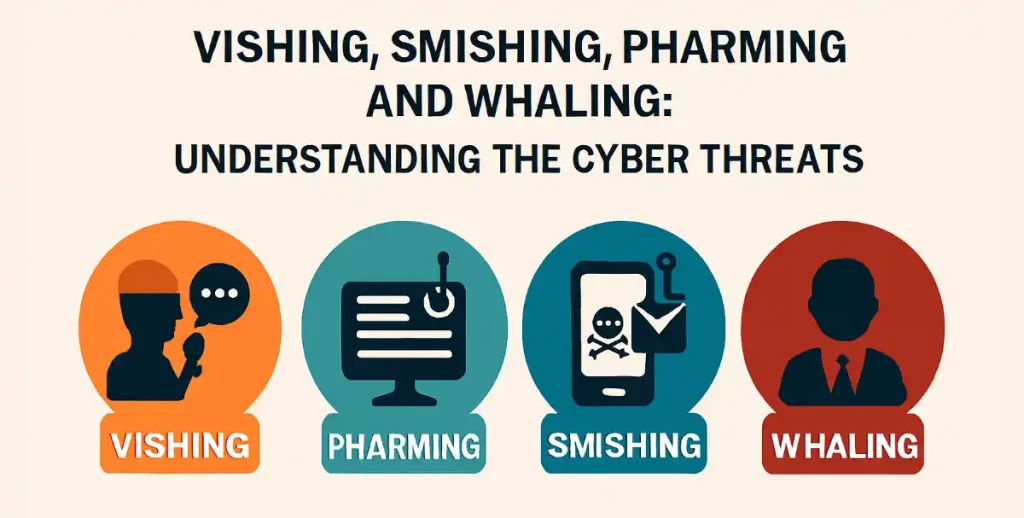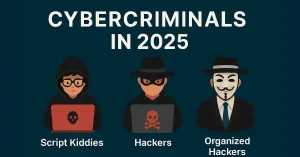In the ever-evolving landscape of cybersecurity, social engineering attacks like vishing, smishing, pharming, and whaling continue to exploit human vulnerabilities alongside network weaknesses. According to the 2025 Verizon Data Breach Investigations Report, phishing variants account for over 30% of breaches, with vishing and smishing rising due to mobile and VoIP adoption. As a network engineer, I see these as threats that bypass traditional firewalls by manipulating protocols like SIP (for VoIP) or DNS. This guide breaks down each term, with examples, technical insights, and prevention strategies for cybersecurity enthusiasts.
Vishing (Voice Phishing)
Vishing, short for voice phishing, is a social engineering attack where fraudsters use phone calls or voice messages to impersonate trusted entities and extract sensitive information like credit card details or login credentials. Unlike email-based phishing, vishing leverages VoIP (Voice over IP) technology to spoof caller IDs, making calls appear from legitimate sources such as banks or government agencies.
From a network engineering perspective, vishing exploits unencrypted SIP (Session Initiation Protocol) in VoIP systems, allowing IP address spoofing. Attackers often use automated robocalls or deepfake audio (AI-generated voices) to create urgency, e.g., “Your account is compromised—provide your PIN now.”
It can occur via landlines, mobile phones, or voice emails, and tracing is difficult due to VoIP’s decentralized nature. Victims trust phone networks more than emails, amplifying the risk.
Vishing Examples
- A fraudster calls pretending to be from your bank, using spoofed caller ID, and requests verification codes sent via SMS.
- In 2024, a widespread vishing campaign targeted executives with AI-deepfake voices mimicking CEOs, leading to unauthorized transfers (per FBI reports).
How to Prevent Vishing
- Enable STIR/SHAKEN protocols on VoIP networks to verify caller IDs.
- Use call-blocking apps and verify callers through official channels (never callback provided numbers).
- Train on recognizing urgency tactics; for networks, implement SIP firewalls to detect anomalies.
Smishing (SMS Phishing)
Smishing, or Short Message Service (SMS) phishing, involves fraudulent text messages that masquerade as legitimate sources to trick users into clicking malicious links, downloading malware, or revealing personal information. Attackers exploit mobile trust, often prompting actions like “Update your account—click here.”
As a network engineer, note that smishing bypasses email filters by using cellular networks‘ SMS gateways, which lack robust spam detection compared to email protocols.
Smishing Examples
- A text claiming “Your package is delayed—track here” leads to a fake site stealing credentials.
- In 2025, smishing rose 20% with AI-generated personalized texts (per Check Point Research).
How to Prevent Smishing
- Enable SMS filtering on carriers (e.g., AT&T’s ActiveArmor).
- Avoid clicking links; visit official apps/websites directly.
- For enterprises, deploy mobile device management (MDM) to monitor SMS traffic on corporate networks.
Pharming (DNS Redirection Phishing)
Pharming is a cyber attack that redirects users from legitimate websites to fraudulent ones without their knowledge, often to steal credentials or install malware. Unlike phishing, it doesn’t require clicking a link—victims are misdirected automatically.
Methods include:
- Modifying local host files via malware emailed to users.
- DNS cache poisoning, where attackers alter DNS server tables to point domains (e.g., bank.com) to fake IPs.
As a network engineer, pharming exploits DNS protocol vulnerabilities (UDP-based, no authentication by default). Anti-spyware won’t detect server-side poisoning, as the user’s device is unaffected.
Pharming Examples
- In the 2018 British Airways breach, attackers poisoned DNS to redirect 500,000 users to a fake payment site, stealing data (resulting in a £20M GDPR fine).
- Modern variants use router malware (e.g., DNSChanger) to affect entire networks.
How to Prevent Pharming
- Implement DNSSEC (Domain Name System Security Extensions) to validate DNS responses.
- Use secure DNS resolvers like Google DNS (8.8.8.8) or Cloudflare (1.1.1.1) with encryption.
- Regularly update routers and enable HTTPS Everywhere to detect mismatches.
Whaling (Executive Phishing)
Whaling is a highly targeted form of phishing aimed at high-profile individuals like executives, politicians, or celebrities. Attackers use personalized social engineering to authorize large transactions or disclose sensitive data.
Tactics include spoofed emails with hyperlinks/attachments, often leveraging researched details (e.g., victim’s name, title). From a network view, whaling exploits email protocols like SMTP without DMARC enforcement.
Whaling Examples
- A fake CEO email requesting a wire transfer, using details from LinkedIn.
- In 2024, a whaling attack on a Fortune 500 firm led to $10M loss via BEC (FBI stats).
How to Prevent Whaling
- Enforce DMARC, DKIM, and SPF on email servers to prevent spoofing.
- Provide executive training on verifying requests via out-of-band channels (e.g., phone).
- Use AI-based anomaly detection in network traffic for unusual email patterns.
Key Differences Between Vishing, Smishing, Pharming, and Whaling
| Attack | Medium | Target | Key Technique | Network Exploitation |
|---|---|---|---|---|
| Vishing | Voice/Phone | General/Individuals | Spoofed calls, urgency | VoIP/SIP spoofing |
| Smishing | SMS/Text | Mobile users | Malicious links | SMS gateways |
| Pharming | Website redirection | Broad users | DNS poisoning | DNS protocol flaws |
| Whaling | Email/Social | High-profile | Personalized spoofing | Email protocols (SMTP) |
Prevention Strategies for Cybersecurity Enthusiasts
- Network-Level Defenses: Deploy firewalls with deep packet inspection for VoIP/SMS traffic; enable DNSSEC and STIR/SHAKEN.
- User Training: Simulate attacks to build awareness; verify all requests.
- Tools: Use SEG (Secure Email Gateways) and MDM for monitoring.
- Stats: Per IBM 2025, training reduces phishing success by 70%.
Conclusion
Understanding vishing, smishing, pharming, and whaling is crucial for robust network security. By implementing technical safeguards and staying vigilant, you can mitigate these threats effectively.
FAQs
What is vishing and how does it differ from traditional phishing?
Vishing, or voice phishing, involves fraudsters using VoIP to spoof calls from legitimate sources, tricking victims into revealing credit card details or personal info. Unlike email-based phishing, it exploits trust in phone networks, using recorded messages or live calls. It’s hard to trace due to VoIP anonymity. To protect yourself, verify caller identities independently and avoid sharing sensitive data over unsolicited calls.
How does smishing work and what risks does it pose?
Smishing uses deceptive SMS texts pretending to be from trusted sources to lure users into clicking links or downloading malware like Trojans or viruses onto mobile devices. Risks include data theft, device compromise, and financial loss. Unlike broader phishing, it targets cell phones specifically. Prevention involves ignoring unsolicited texts, using antivirus apps, and reporting suspicious messages to carriers.
What are the methods used in pharming attacks?
Pharming redirects users to fake websites by infecting computers with code that alters host files or poisoning DNS servers, capturing credentials without user awareness. Methods include email-delivered malware or DNS table modifications. It affects multiple users at once, unlike targeted phishing. Anti-spyware won’t detect DNS-based pharming. Use secure DNS services and HTTPS to mitigate risks.
How is whaling different from standard phishing attacks?
Whaling is a sophisticated phishing variant targeting high-profile individuals like executives, politicians, or celebrities with personalized emails or sites to authorize large transfers or reveal corporate secrets. It uses social engineering, spoofed content, and malware. Detection is harder due to customization. Reduce risks through security training for management and verifying unusual requests.
What is gene pharming and how does it relate to cyber pharming?
Gene pharming involves altering animal DNA to produce human proteins in milk, eggs, or blood for drug manufacturing, unrelated to cyber threats. Cyber pharming, however, is a scam redirecting users to fraudulent sites. The article mentions gene pharming as a separate type but focuses on cybersecurity. No direct relation exists; it’s likely included for completeness on pharming variants.





